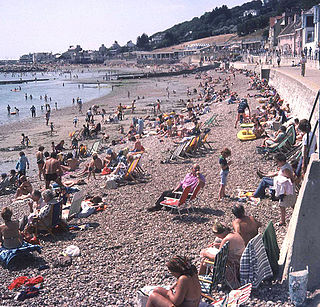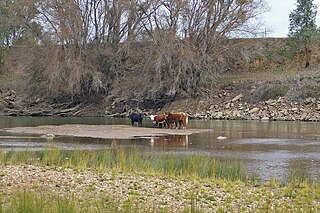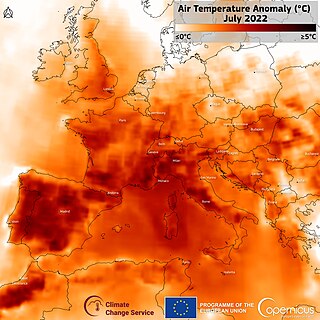
The United Kingdom straddles the higher mid-latitudes between 49° and 61°N on the western seaboard of Europe. Since the UK is always in or close to the path of the polar front jet stream, frequent changes in pressure and unsettled weather are typical. Many types of weather can be experienced in a single day.

A period of unusually hot summer weather occurred in the British Isles during the summer of 1976. At the same time, there was a severe drought on the islands of Great Britain and Ireland. It was one of the driest, sunniest and warmest summers (June/July/August) in the 20th century, although the summer of 1995 is now regarded as the driest. Only a few places registered more than half their average summer rainfall. In the Central England temperature record, it was the warmest summer in the series until being surpassed in the 21st century. It was the warmest summer in the Aberdeen area since at least 1864, and the driest summer since 1868 in Glasgow.
An outdoor water-use restriction is a ban or other lesser restrictions put into effect that restricts the outdoor use of water supplies. Often called a watering ban or hosepipe ban, it can affect:

The 2006 European heat wave was a period of exceptionally hot weather that arrived at the end of June 2006 in certain European countries. The United Kingdom, France, Belgium, the Netherlands, Luxembourg, Italy, Poland, the Czech Republic, Hungary, Germany and western parts of Russia were most affected.

The British Isles are an archipelago off the northwest coast of Europe, consisting of the islands of Great Britain and Ireland along with smaller surrounding ones. Its position allows dry continental air from Eurasia to meet wetter air from the Atlantic Ocean, which causes the weather to be highly variable, often changing many times during the day. It is defined as a temperate oceanic climate, or Cfb on the Köppen climate classification system. It is significantly warmer than other regions on the same latitude, previously thought to be due to the warmth provided by the Gulf Stream; however, this has been disproven, and most of the mild temperatures have been linked to the Rocky Mountains and the heat storing capabilities of the North Atlantic Ocean. Temperatures do not often switch between great extremes, with warm summers and mild winters.

Climate change has been a critical issue in Australia since the beginning of the 21st century. Australia is becoming hotter and more prone to extreme heat, bushfires, droughts, floods, and longer fire seasons because of climate change. Climate issues include wildfires, heatwaves, cyclones, rising sea levels, and erosion.

Droughts are a relatively common feature of the weather in the United Kingdom, with one around every 5–10 years on average. These droughts are usually during the summer, when a blocking high causes hot, dry weather for an extended period. However this means that droughts can vary in their characteristics. All types of drought cause issues across all sectors, with impacts extending to the ecosystem, agriculture and the economy of the whole country in severe cases of drought. The south east of the country usually suffers most, as it has the highest population and the lowest average precipitation per year, which is even lower in a drought. Even in these areas in severe droughts, the definition, impacts, effects and management are all minimal in comparison to drought prone areas such as Australia and parts of the United States. In recent years however, the summers of 2007, 2008, 2009, August 2010 and 2012 were wetter than normal, 2007 being wettest on record. Droughts have continued to occur in recent times, with spring 2011, July 2013, summer 2018, spring 2020, spring and summer 2022 and May and June 2023 all featuring excessively dry periods for part or all of the UK, and will likely become more severe due to climate change over the 21st century.

The 2000s drought in Australia, also known as the millennium drought is said by some to be the worst drought recorded since European settlement.
The 2016 Indian heat wave was a major heat wave in April and May of that year. A national record high temperature of 51.0 °C (123.8 °F) was set in the town of Phalodi, in the state of Rajasthan. Over 1,100 people died with 330 million affected to some degree. There were also water shortages with drought worsening the impact of the heat wave.

The 1995 British Isles heatwave occurred between late July and late August. It was part of one of the warmest summers recorded in the UK, and one of the warmest Augusts ever recorded in many locations around the UK, as well as being one of the driest summers ever recorded in the UK; many weather stations recorded the summer of 1995 as drier than, or comparable with, the summer of 1976. Ireland was also widely affected by the heatwave with temperatures reaching over 30 °C (86 °F) in some locations, as well as exceptionally low rainfall throughout the summer.

The 2018 Britain and Ireland heatwave was a period of unusually hot weather that took place in June, July and August. It caused widespread drought, hosepipe bans, crop failures, and a number of wildfires. These wildfires worst affected northern moorland areas around the Greater Manchester region, the largest was at Saddleworth Moor and another was at Winter Hill, together these burned over 14 square miles (36 km2) of land over a period of nearly a month.

The 2018 European drought and heat wave was a period of unusually hot weather that led to record-breaking temperatures and wildfires in many parts of Europe during the spring and summer of 2018. It is part of a larger heat wave affecting the northern hemisphere, caused in part by the jet stream being weaker than usual, allowing hot high-pressure air to linger in the same place. According to the European Drought Observatory, most of the areas affected by drought are across northern and central Europe. According to the World Meteorological Organization, the severe heat waves across the northern hemisphere in the summer of 2018, are linked to climate change in Europe, as well as events of extreme precipitation.

A drought developed in the Western, Midwestern, and Northeastern United States in the summer of 2020. Similar conditions started in other states in August 2020, including Iowa, Nebraska and certain parts of Wisconsin and Minnesota. At the same time, more than 90% of Utah, Colorado, Nevada and New Mexico were in some level of drought. Also in drought conditions were Wyoming, Oregon and Arizona.

The 2022 United Kingdom heatwaves were part of several heatwaves across Europe and North Africa. The United Kingdom experienced three heatwaves; the first was for three days in June, the second for three days in July, and the third for six days in August. These were periods of unusually hot weather caused by rising high pressure up from the European continent. There were also more grass fires and wildfires than average, and in August a drought was declared in many regions.

From June to August 2022, persistent heatwaves affected parts of Europe, causing evacuations and a confirmed death toll of 24,501. However, upper estimates suggested more than 61,000 heat-related deaths between 30 May and 4 September. These heat waves were the deadliest meteorological events in 2022. The highest temperature recorded was 47.0 °C (116.6 °F) in Pinhão, Portugal, on 14 July.
2020s in climate history refers to major events pertaining to the climate, this includes extreme weather, as well as new scientific phenomena and occurrences which pertain to the climate. This article will be structured by category of data, and then chronologically within those broader sections.

During the summer of 2022, parts of Europe experienced drought conditions exacerbated by heat waves. This was preceded by a warm and dry spring. On 9 August, a senior European Commission researcher said that it seemed to be Europe's worst year in 500 years. A report from the Global Drought Observatory has confirmed this. The drought had serious consequences for hydropower generation and the cooling systems of nuclear power plants, as the drought reduced the amount of river water available for cooling. Agriculture in Europe was also negatively affected by the drought.
Events of 2022 in England. The Queen's platinum jubilee took place in February; she died in September. England's hottest temperatures on record occurred in July.

Since the beginning of March 2023, most of Canada experienced a drought, which was severe across the Prairie provinces and unprecedented in British Columbia. Every province and territory was in drought simultaneously. Common factors across Canada were a quick snow melt, sometimes due to a below-average snowpack, and the warmest May-June period in more than 80 years. Moderate to severe drought conditions from British Columbia to northern Ontario persisted until fall.















